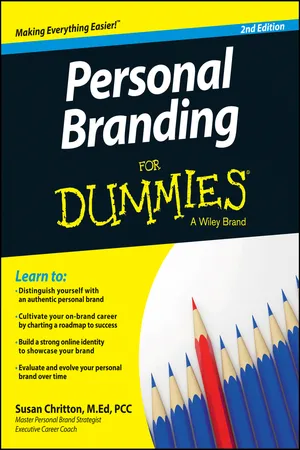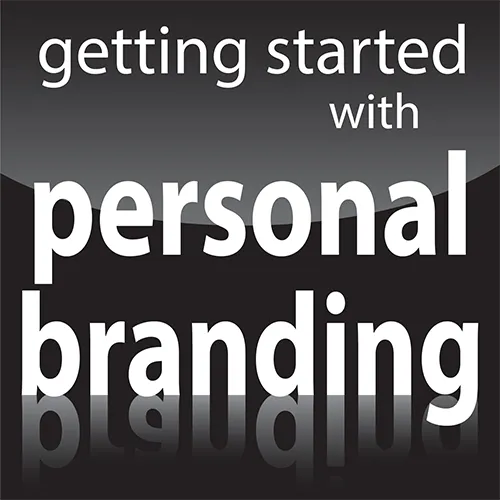
- English
- ePUB (mobile friendly)
- Available on iOS & Android
Personal Branding For Dummies
About This Book
The simple guide to managing your personal brand, a vital element of success in the professional world
Personal Branding For Dummies, 2 nd Edition, is your guide to creating and maintaining a personal trademark by equating self-impression with other people's perceptions. This updated edition includes new information on expanding your brand through social media, online job boards, and communities, using the tried and true methods that are the foundation of personal branding. Marketing your skills and personality, and showing the rest of the world who you are, gives you a competitive edge. Whether you're looking for your first job, considering changing careers, or just want to be more viable and successful in your current career, this guide provides the step-by-step information you need to develop your personal brand.
Distinguishing yourself from the competition is important in any facet of business, and the rise of personal branding has evolved specifically to help candidates stand out from the global talent pool. Establishing a professional presence with a clear and concise image, reputation, and status is a must, whether you're a new grad or an accomplished executive. Personal marketing has never been more important, and your personal brand should communicate the best you have to offer. Personal Branding For Dummies, 2 nd Edition, leads you step by step through the self-branding process.
- Includes information on how to know the "real" you
- Explains how to develop a target market positioning statement
- Helps you make plans for your personal brand communications
- Instructs you with ways to make your mark on your brand environment
The book also discusses continued brand building, demonstrating your brand, and the 10 things that can sink your brand. A personal brand is more than just a business card and a resume. It should be exquisitely crafted to capture exactly the image you wish to project. Personal Branding For Dummies, 2 nd Edition provides the information, tips, tricks, and techniques you need to do it right.
Frequently asked questions
Information
Why Is Personal Branding Important?

- Distinguish yourself by creating your personal brand and recognizing what’s at stake if you don’t.
- Grasp the process of building a positive set of experiences using key brand elements.
- Learn from others who have created memorable personal brands.
Showing the World Who You Are





Discovering Personal Branding
- “She is so smart.”
- “He is such a slob.”
- “I can always count on him to finish what he starts.”
Know your brand
- Define who you are. The beginning of any branding process is being able to clearly define that brand. In personal branding, the product is you! You must take time to get to know yourself and what is important to you. That’s what Chapter 4 is all about.
- Spot your target audience. Are you interacting with and trying to promote yourself to the right people? In Chapter 5, I help you determine who needs to know about your personal brand.
- Get to know your competitors. Whom are you competing with? To have a strong brand, you need to understand who your competitors are and which market niche works for you. Chapter 6 gives you the tools to accomplish this step.
- Craft a personal brand profile. This all-important tool, which I discuss in detail in Chapter 7, gathers all the data that you collect about yourself, your target audience, and your competitors into one defining document. This profile helps you pinpoint your unique promise of value and write a statement that succinctly expresses your brand.
Communicate your brand
- Write your story. Chapter 8 is a lesson on how to make your story appealing to others. You need to be able to tell others about yourself and to develop a personal commercial (or an elevator pitch).
- Brand your traditional communication tools. You want to express your personal brand in your letters, resume, professional biography, and presentations — and, if you have the opportunity, on television. Chapter 9 shows you how.
- Communicate your brand online. Chapter 10 demonstrates how to merge the world of social media with your personal brand.
- Create a communications plan. You need a communications plan so that you’re sharing your brand on your own terms — not leaving anything to chance. Chapter 11 gives you the inside scoop on how to craft a communications plan.
Control your brand ecosystem
- Your image: Whether you like it or not, what you look like on the outside does matter. Fashioning your image to match your personal brand helps you communicate something authentic about yourself at first glance, and Chapter 12 shows you how.
- The appearance of your branded materials: From business cards to your website, you want to create a consistent visual image for your brand that makes the right impression on your target audience. Chapter 13 explains how to select images, colors, and fonts that create the visual effect you want.
- Your unique career path: Your target audience — and the way you interact with it — is determined by where you are in your career. In Chapter 14, I discuss special considerations to keep in mind if you’re just out of college, if you’re midstream in your career and trying to switch jobs, if you’re an executive, if you’re an entrepreneur, and more.
- Your network: The people you associate with are very important; they factor into the impression you make on your target audience, as well as your ability to make connections with future employers. Chapter 15 is full of tips for finding people who can support your goals and connecting with them in meaningful ways.
- Your performance in your current workplace: Personal branding is not just for job seekers. If you’re already employed, Chapter 16 offers lots of ideas for developing your personal brand in the context of your current workplace.
Figuring Out Who You Really Are
Shedding others’ ideas and expectations
Table of contents
- Cover
- Title Page
- Table of Contents
- Introduction
- Part I: Why Is Personal Branding Important?
- Part II: Knowing Your Brand
- Part III: Communicating Your Brand with the World
- Part IV: Controlling Your Brand Ecosystem
- Part V: The Part of Tens
- About the Author
- Cheat Sheet
- More Dummies Products
- End User License Agreement

